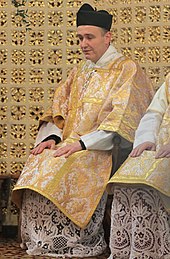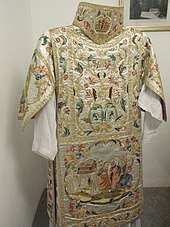Dalmatic


Thedalmaticis a long, wide-sleevedtunic,which serves as a liturgicalvestmentin theCatholic,Lutheran,Anglican,United Methodist,and some other churches. When used, it is the proper vestment of adeaconatMass,Holy Communionor other services such asbaptismormarriageheld in the context of aEucharisticservice. Although infrequent, it may also be worn bybishopsabove thealband below thechasuble,and is then referred to aspontifical dalmatic.
Like the chasuble worn by priests and bishops, it is an outer vestment and is supposed to match theliturgical colourof the day. The dalmatic is often made of the same material and decoration as a chasuble, so as to form a matching pair. TraditionalSolemn Massvestment sets include matching chasuble, dalmatic, andtunicle.
History
[edit]In theRoman Empire,the dalmatic was an amply sleevedtunic(fromDalmatia) with wide stripes(clavi)that were sometimes worked with elaborate designs. Dalmatics had become typical attire for upper-class women in the latter part of the 3rd century AD. They are pictured in a few funerary portraits on shrouds fromAntinoopolisinRoman Egypt.[1]Literary sources record dalmatics as imperial gifts to individuals.[2]
It was a normal item of clothing at the time when ecclesiastical clothes began to develop separately around the fourth century, worn over a longer tunic by the upper classes, and as the longest part of the dress of men of lower rank.
The dalmatic was a garment ofByzantine dress,and was adopted by EmperorPaul Iof theRussian Empireas a coronation and liturgical vestment. InOrthodoxiconsofJesus ChristasKingand GreatHigh Priesthe is shown in a dalmatic.[3]
Roman Church
[edit]
The dalmatic is a robe with wide sleeves; it reaches to at least the knees or lower. In 18th-century vestment fashion, it is customary to slit the under side of the sleeves so that the dalmatic becomes a mantle like ascapularwith an opening for the head and two square pieces of the material falling from the shoulder over the upper arm. Modern dalmatics tend to be longer and have closed sleeves, with the sides being open below the sleeve. The distinctive ornamentation of the vestment consists of two vertical stripes running from the shoulder to the hem; according to Roman usage these stripes are narrow and sometimes united at the bottom by two narrow cross-stripes. Outside of Rome the vertical stripes are quite broad and the cross-piece is on the upper part of the garment. At aPontifical High Mass,a dalmatic (usually made of lighter material) is worn by the bishop under the chasuble. At solemn papal liturgical occasions the Pope is assisted by twocardinal-deaconseach vested in a dalmatic and wearing amitra simplex(simple whitemitre).
In the Roman Catholic Church thesubdeaconswore a vestment called thetunicle,which was originally distinct from a dalmatic, but by the 17th century the two had become identical, though a tunicle was often less ornamented than a dalmatic, the main difference often being only one horizontal stripe versus the two becoming a deacon's vestment. Additionally, unlike deacons, subdeacons do not wear astoleunder their tunicle. Today, the tunicle is rare in the Roman Catholic Church as only certain authorized clerical societies (such as thePriestly Fraternity of St. Peter) have subdeacons.
Traditionally the dalmatic was not used in theRoman Riteby deacons duringLent.In its place, depending on the point in the liturgy, was worn either a foldedchasubleor what was called a broadstole,which represented a rolled-up chasuble. This tradition went back to a time at which the dalmatic was still considered an essential secular garment and thus not appropriate to be worn during the penitential season of Lent.
-
Dalmatic Roman usage (with its closed sleeves)
-
Baroque dalmatic (with slit, flap-like sleeves common for dalmatics worn outside Italy)
-
Capa pluvial(cope) and ornately embroidered dalmatic pairs (late 1800s, early 1900s,Our Lady of Manaoagmuseum,Philippines)
Eastern tradition
[edit]
In theByzantine Ritethesakkos,which is elaborately decorated and amply cut, usually worn by the bishops as an outer vestment in place of a presbyter'sphelonionand which, like thephelonion,corresponds to the westernchasubleandcope,is derived from Byzantine imperial dress, and hence is identical in origin to the Western dalmatic.
In allEastern ritesthesticharion(which is analogous to the Westernalb), of the ornate sort worn by deacons and lower clergy, is sometimes referred to as a dalmatic.
References
[edit]External links
[edit]- Phillips, Walter Alison(1911)..Encyclopædia Britannica.Vol. 7 (11th ed.). pp. 776–777.
![]() This article incorporates text from a publication now in thepublic domain:Braun, Joseph (1908). "Dalmatic".Catholic Encyclopedia.Vol. 4.
This article incorporates text from a publication now in thepublic domain:Braun, Joseph (1908). "Dalmatic".Catholic Encyclopedia.Vol. 4.



